
Norwood Park is one of the 77 Chicago community areas. It encompasses the smaller neighborhoods of Big Oaks, Norwood Park East, Norwood Park West, Old Norwood Park, Oriole Park, and Union Ridge.

The Wholesale District is one of six designated cultural districts in Indianapolis, Indiana, United States. Located on in the southern section of Downtown Indianapolis' Mile Square, the Wholesale District contains several notable attractions, such as Gainbridge Fieldhouse, Circle Centre Mall, and the Soldiers' and Sailors' Monument.

The Marquette Building, completed in 1895, is a Chicago landmark that was built by the George A. Fuller Company and designed by architects Holabird & Roche. The building is currently owned by the John D. and Catherine T. MacArthur Foundation. It is located in the community area known as the "Loop" in Cook County, Illinois, United States.

The Villa District, also known as Villa Historic District, is a historic district in Chicago, Illinois, United States. It is located on Chicago's Northwest Side within the community area of Irving Park. Its borders are along Pulaski Road to the west, the Union Pacific/Northwest rail line to the north, Hamlin Avenue to the east, and Addison Street to the south. Located directly north of the Wacławowo area of Avondale, the Villa District is serviced by the Blue Line's Addison street station.

The Boston–Edison Historic District is a historic neighborhood located in the geographic center of Detroit, Michigan. It consists of over 900 homes built on four east/west streets: West Boston Boulevard, Chicago Boulevard, Longfellow Avenue, and Edison Avenue, stretching from Woodward Avenue on the east to Linwood Avenue on the west. It is one of the largest residential historic districts in the nation. It is surrounded by Sacred Heart Major Seminary to the west, the Arden Park-East Boston Historic District and the Cathedral of the Most Blessed Sacrament to the east, and the Atkinson Avenue Historic District to the south. The district was designated a Michigan State Historic Site in 1973 and listed on the National Register of Historic Places in 1975.

Portage Park is a 36-acre (15 ha) park in the Portage Park community area of Chicago, Illinois on the National Register of Historic Places. The park stretches from Irving Park Road on the south to Berteau Avenue between Central and Long Avenues. The largest public park on Chicago's Northwest Side, it has many recreational facilities including six tennis courts, two playgrounds, a slab for in-line skating, a bike path, a nature walk, five baseball fields, two combination football/soccer fields and two fieldhouses— one housing a gymnasium and the other a cultural arts building. The park also has an Olympic-size pool featuring a large deck for sunning, misting sprays, as well as an interactive water play area with slide and diving boards in addition to a smaller heated pool. Plans are currently underway for the development of a new, 6,500-square-foot (600 m2) senior center at Portage Park.

Jefferson Park is a 7-acre (2.8 ha) park in the Jefferson Park community area of Chicago, Illinois on the National Register of Historic Places.

Humboldt Park is a 207-acre (84 ha) park located at 1400 North Sacramento Avenue on the West Side of Chicago, Illinois.

Indian Boundary Park is a 13-acre (5.3 ha) urban park in the West Ridge neighborhood of North Side, Chicago, Illinois.

Edison Storage Battery Company Building, is located at 177 Main Street and Lakeside Avenue in West Orange, Essex County, New Jersey, United States. The building was added to the National Register of Historic Places on February 28, 1996.
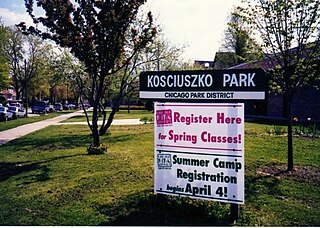
Kosciuszko Park is a park located at 2732 N. Avers Ave. Situated along the northern boundary of Chicago's Logan Square community area at Diversey, it is heavily frequented by residents of Avondale and is considered to be part of Jackowo.
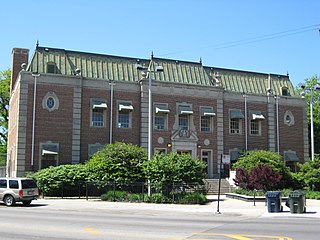
Riis Park is a 56-acre park on Chicago's Northwest Side in the Belmont-Cragin neighborhood. The park is named for Jacob Riis, a famous New York City muckraker journalist and photographer who documented the plight of the poor and working class. Riis was designed to include a variety of recreational amenities for the middle class community that it served. It was developed in 1928 when a ski jump and golf course was installed. Chicago Architect Walter W. Ahlschlager designed the fieldhouse.

The Shedd Park Fieldhouse is the historic fieldhouse in Shedd Park, a public park in the South Lawndale community area of Chicago, Illinois. John G. Shedd, for whom the park and fieldhouse are named, gave the city the land for the park. The Prairie School building was designed by William Drummond and built in 1917. The brown brick building features limestone trim. A Prairie School gymnasium designed by Michaelsen and Rognstad was added to the building in 1928.

Hamilton Park is a public park at 513 W. 72nd Street in the Englewood neighborhood of Chicago, Illinois. The park opened in 1904 as part of a plan led by the South Park Commission to add small neighborhood parks on Chicago's South Side. It was the first public park in Englewood. Landscape designers the Olmsted Brothers and architecture firm D. H. Burnham & Company collaborated on the park's design. The park opened with a fieldhouse, baseball field, wading pool, and walkways; within the decade, the designers added gymnasiums, a playground, and tennis courts. The fieldhouse has a Beaux-Arts design, and its inside features several murals of prominent figures in American history. The park was heavily used after it opened, and the fieldhouse in particular was booked so consistently that it was expanded in the 1920s.
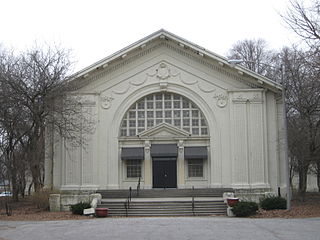
Trumbull Park is a public park at 2400 E. 105th Street in the South Deering neighborhood of Chicago, Illinois. The South Park Commission opened the park in 1907 as part of its efforts to bring parks to dense immigrant neighborhoods with little green space. The park's fieldhouse and other facilities were not completed until the 1910s; around this time, the park was officially named for Lyman Trumbull, a United States Senator from Illinois who co-wrote the Thirteenth Amendment. While the park and its facilities were designed in-house by the South Park Commission, they were inspired by the designs of landscape architects the Olmsted Brothers and architecture firm D. H. Burnham and Company used in many of the South Park Commission's other parks. The fieldhouse in particular has a Beaux-Arts design which calls back to Burnham's work for the 1893 Columbian Exposition.
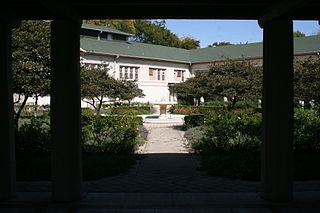
Fuller Park is a public park at 331 W. 45th Street in the neighborhood of the same name in Chicago, Illinois, United States. The park was one of several built by the South Park Commission in the early 20th century to provide parks in dense and poor South Side Chicago neighborhoods which lacked them. While most of the South Park Commission parks opened in the mid-1900s, work on Fuller Park did not begin until 1910 due to a dispute over its location, and its facilities gradually opened over the next four years. The park was named for Melville Fuller, an Illinois native and former Chief Justice of the United States. The South Park Commission designed the park's landscape in a similar style to their earlier parks, which had been designed by the Olmsted Brothers; D. H. Burnham and Company designed its buildings, as they had for the earlier parks. The park originally included a Beaux-Arts fieldhouse, a gymnasium, a bathhouse, a grandstand, and a running track and walking paths. Fuller Park was first settled by Irish immigrants in the later 1860s after the Union Stock Yards opened on Christmas Day 1865. This area became a part of the Lake Township area and after the Great Chicago Fire of 1871 and the opening of the Lake Shore & Michigan Southern Railroad the area flourished into a community.

Davis Square is a public park located between 44th and 45th Streets and Marshfield and Hermitage Avenues in the New City community area of Chicago, Illinois. The park opened in 1905 as one of the initial parks in the South Park Commission's plan to build parks in the dense, poor neighborhoods of Chicago's South Side. It was named for Nathan Smith Davis, a Chicago physician and one of the founders of the American Medical Association. As they did for most of the South Park Commission's parks, the Olmsted Brothers designed Davis Square's landscape, while D. H. Burnham and Company designed its facilities. The park initially included a Beaux-Arts styled fieldhouse, a swimming pool and pool house, baseball fields, and walking paths.
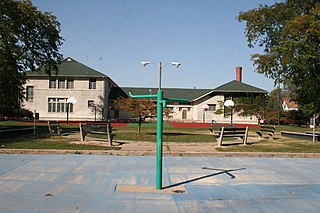
Cornell Square is a public park at 1809 W. 50th Street in the New City community area of Chicago, Illinois. Opened in 1905, the park was one of many planned by the South Park Commission to provide parks in dense, poor South Side neighborhoods. The park was named for Paul Cornell, one of the Commission's board members. As with the South Park Commission's other early parks, landscape architects the Olmsted Brothers designed the park's layout while D. H. Burnham and Company designed its facilities. The park originally included a fieldhouse with gymnasium facilities, a swimming pool, athletic fields, and walking paths. The fieldhouse has a Beaux-Arts design and includes a painting of Ezra Cornell, the founder of Cornell University and Paul Cornell's cousin.

Grand Crossing Park is a public park at 7655 S. Ingleside Avenue in the Greater Grand Crossing neighborhood of Chicago, Illinois. Opened in 1915, the park was planned by the South Park Commission, which was responsible for adding several parks in dense, poor South Side neighborhoods. While the South Park Commission designed the park and its facilities in-house, its designs were heavily influenced by the work of the Olmsted Brothers and D. H. Burnham and Company in its earlier parks. The park originally included a Beaux-Arts fieldhouse, a swimming pool, outdoor gymnasiums, a baseball field, tennis courts, and running and walking paths. The fieldhouse includes indoor gymnasiums, meeting rooms, and a series of murals titled An Allegory of Recreation.
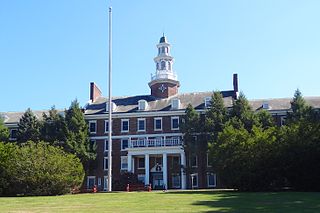
Roosevelt Hospital is a historic building at 1 Roosevelt Drive in Edison, Middlesex County, New Jersey. Construction of the hospital was started in 1935 and completed in 1937. The building was added to the National Register of Historic Places on March 5, 2002 for its significance in health and medicine, in particular the treatment of tuberculosis. It was designed with Colonial Revival style and built with red brick.























